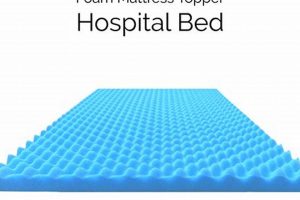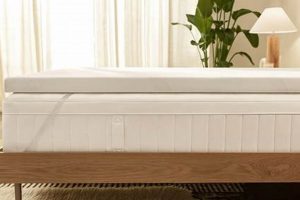This product category refers to a cushioning layer designed to be placed atop a mattress. It aims to enhance comfort and support. These items frequently utilize materials like memory foam, gel-infused foam, or down alternatives to modify the existing feel of a sleep surface. An example would be a thick, supportive layer intended to alleviate pressure points.
These comfort layers are valuable for extending the lifespan of a mattress or improving the sleep quality without the expense of a replacement. They can address issues such as a mattress that is too firm or lacks adequate support. Historically, simpler versions of these products were used to protect mattresses, but modern iterations focus on improving sleep ergonomics and temperature regulation.
The following sections will address factors to consider when choosing such a product, including material types, thickness options, and care instructions, enabling informed purchase decisions.
Guidance on Selecting Mattress Overlays
The following considerations are crucial when evaluating a mattress overlay, aiming to maximize its benefits and suitability for individual needs.
Tip 1: Material Composition: Evaluate the material based on individual preferences for firmness and temperature regulation. Memory foam offers significant pressure relief but can retain heat. Latex provides responsiveness and breathability. Down alternatives offer a softer, more affordable option.
Tip 2: Thickness Considerations: Thickness affects the degree of comfort alteration. A thinner overlay (1-2 inches) provides subtle adjustments, whereas a thicker one (3-4 inches) offers more substantial cushioning and support.
Tip 3: Density and Support: Higher density materials generally offer improved support and durability. Consider body weight and sleeping position when determining the appropriate density level.
Tip 4: Temperature Regulation: For individuals prone to overheating, opt for overlays with cooling technologies such as gel infusions or breathable fabrics. These features promote airflow and dissipate heat.
Tip 5: Size Compatibility: Ensure the overlay dimensions precisely match the mattress size to prevent shifting or overhang. Accurate measurements are essential for optimal performance.
Tip 6: Care and Maintenance: Review the care instructions to understand cleaning requirements. Some overlays may be spot-cleaned only, while others are machine washable. Proper maintenance extends the lifespan of the product.
Tip 7: Warranty and Returns: Consider selecting a product with a reasonable warranty and a clear return policy. This allows for testing and evaluation within a specified timeframe.
Selecting a compatible mattress overlay requires careful evaluation of material properties, dimensions, and care requirements. Matching the product to individual needs ensures optimal comfort and value.
The next section provides further context on maintaining hygiene and extending the product’s usable life.
1. Material Composition and Mattress Overlays
The material composition of a mattress overlay directly dictates its performance characteristics, influencing factors such as comfort, support, temperature regulation, and durability. The selection of materials therefore stands as a foundational element in determining the suitability of the product for individual needs. Different materials exhibit distinct properties that impact the sleep experience. For instance, memory foam conforms closely to the body, offering pressure relief but potentially trapping heat. Latex, on the other hand, provides responsiveness and breathability, but may not offer the same level of contouring.
The interplay between material properties and individual sleep preferences highlights the importance of informed selection. A high-density memory foam overlay may offer enhanced support for individuals with back pain, while a gel-infused foam aims to mitigate heat retention, benefitting those who tend to overheat during sleep. Considering these cause-and-effect relationships is essential when making a purchasing decision. For example, an individual prioritizing spinal alignment may benefit from a firmer latex overlay, whereas those seeking plush comfort may find a down-alternative option more suitable.
In conclusion, material composition is a critical determinant of the suitability and effectiveness of a mattress overlay. It directly influences comfort, support, and temperature regulation, underscoring the need for careful consideration during the selection process. Understanding the inherent properties of different materials and aligning them with individual sleep needs ensures optimal satisfaction and long-term product performance.
2. Thickness Options
Thickness options available in mattress overlays significantly impact the level of comfort and support alteration provided to the underlying mattress. The appropriate thickness is contingent on individual preferences and the desired degree of change to the existing sleep surface.
- Subtle Adjustment (1-2 inches)
Overlays in this thickness range offer a minimal alteration to the existing mattress feel. They are suitable for individuals seeking slight improvements in comfort without significantly changing the overall support characteristics. For example, a thin memory foam overlay can add a touch of pressure relief without compromising the firmness of the mattress. This option is often selected when the primary concern is minor discomfort or a desire to extend the lifespan of a nearly new mattress.
- Moderate Enhancement (2-3 inches)
This thickness provides a more noticeable change in comfort and support. These overlays can effectively alleviate pressure points and improve spinal alignment. An individual with mild back pain might find relief with a 2-3 inch gel-infused memory foam overlay. This thickness represents a balance between comfort enhancement and preserving the inherent support of the existing mattress. It addresses moderate discomfort issues without drastically altering the original sleep surface.
- Significant Alteration (3-4 inches)
Overlays in this thickness range offer a substantial transformation of the mattress feel. They are designed to address significant comfort deficiencies or to substantially soften a very firm mattress. A 3-4 inch down alternative overlay, for instance, can create a plush sleep surface on a firm innerspring mattress. This option is suitable for those seeking a dramatic change in comfort, often mitigating the need to replace an otherwise functional but uncomfortable mattress.
- Specialty Thickness (Greater than 4 inches)
Overlays exceeding 4 inches are less common and are typi
cally reserved for specific situations, such as accommodating medical conditions or creating a custom sleep environment. These thicker options provide maximum cushioning and pressure relief. For example, a thicker overlay might be used to accommodate individuals with severe pressure sores or those requiring highly specialized support. The significant height added by these overlays may necessitate adjustments to bed linens and frame height.
The selection of the correct thickness necessitates a careful assessment of individual needs and preferences, considering factors such as body weight, sleeping position, and the condition of the existing mattress. While a thinner overlay offers subtle adjustments, thicker options provide more substantial alterations to the sleep surface, directly impacting comfort and support characteristics.
3. Density Levels
Density, measured in pounds per cubic foot (lbs/ft), is a crucial factor in determining the performance and longevity of mattress overlays. It dictates the support, durability, and overall feel. The density of materials used directly correlates with the ability of the topper to conform to the body, alleviate pressure points, and resist sagging over time.
- Support and Conformity
Higher density materials provide enhanced support and conformity. They offer greater resistance to compression, maintaining spinal alignment and distributing weight evenly. For example, a high-density memory foam topper will contour closely to the body, providing targeted support to pressure points such as the shoulders and hips. This results in a more comfortable and supportive sleep surface.
- Durability and Longevity
Density directly affects the product’s durability. Higher density materials are more resilient and less prone to breakdown, maintaining their shape and support over extended use. A low-density topper may compress and lose its supportive qualities within a relatively short period, whereas a higher density option will retain its integrity for a longer duration. This difference impacts the long-term value and usability of the product.
- Pressure Relief
The ability of an overlay to relieve pressure points is linked to its density. Higher density materials effectively distribute weight, reducing stress on specific areas of the body. This is particularly beneficial for individuals with joint pain or those who spend extended periods in one position. The enhanced pressure relief contributes to improved sleep quality and reduced discomfort.
- Temperature Regulation (Indirect)
While density itself does not directly regulate temperature, it influences the breathability of certain materials. Higher density memory foam, for example, can trap heat due to its reduced airflow. Conversely, open-cell foams, regardless of density, offer improved ventilation. The relationship between density and material type must be considered to optimize temperature regulation. A higher density, breathable material is generally preferable for temperature-sensitive individuals.
In summary, density is a key determinant of the performance characteristics of a mattress overlay. It influences support, durability, pressure relief, and indirectly impacts temperature regulation. Selecting an appropriate density level, in conjunction with the material type, ensures optimal comfort, longevity, and overall value. The interplay of these factors dictates the effectiveness of the product in meeting individual needs and preferences.
4. Temperature Regulation
Temperature regulation is a significant consideration in mattress overlay design and material selection. The ability of a sleep surface to dissipate heat and maintain a comfortable temperature is a key determinant of sleep quality. Materials used in these products have varying thermal properties, influencing heat retention or dissipation. For example, traditional memory foam is known for its tendency to trap heat, potentially leading to discomfort for sleepers who tend to overheat. This can lead to disrupted sleep cycles and reduced overall restfulness.
To address heat retention issues, manufacturers incorporate cooling technologies into these products. Gel-infused memory foam is one common approach, where gel particles are added to the foam to improve heat conductivity. Open-cell foam structures are also utilized to promote airflow and reduce heat buildup. Natural materials like latex often exhibit better breathability compared to synthetic foams, making them a more favorable option for temperature regulation. Individuals experiencing night sweats or residing in warmer climates may benefit from overlays specifically designed with these cooling properties. The effectiveness of these technologies can vary, and consumer reviews often provide insights into the real-world performance of different cooling features.
In summary, temperature regulation is a crucial aspect of mattress overlay design and functionality. The selection of materials and incorporation of cooling technologies directly impact the ability of the product to maintain a comfortable sleep environment. Individuals should consider their personal temperature preferences and sleep habits when evaluating the temperature regulation capabilities of various mattress overlay options. Failure to address this aspect may lead to discomfort and compromised sleep quality.
5. Size Compatibility
Size compatibility represents a critical factor in the effective utilization of a mattress topper. The dimensions of the topper must precisely correspond to the dimensions of the underlying mattress to ensure proper fit and functionality. A mismatch in size can result in several adverse effects, including shifting, bunching, or overhang, each of which diminishes the intended comfort and support benefits. For example, a queen-size topper placed on a full-size mattress will create an unstable and uneven sleep surface, negating the potential advantages of the topper.
The importance of correct sizing extends beyond mere aesthetics. A properly sized topper distributes weight evenly across the sleep surface, contributing to optimal spinal alignment and pressure relief. Conversely, an ill-fitting topper can create pressure points and disrupt sleep posture. For example, if a topper is too short for the mattress, the sleeper’s feet may extend beyond the edge, leading to discomfort. Accurate measurement of the mattress prior to purchase is therefore essential. Mattress sizes typically adhere to standardized dimensions (e.g., Twin, Full, Queen, King, California King), but slight variations may exist. It is prudent to verify the exact dimensions before selecting a topper.
In conclusion, size compatibility is not merely a cosmetic consideration but a fundamental aspect of mattress topper functionality. Proper sizing ensures optimal comfort, support, and longevity of the product. Addressing this factor during the selection process mitigates potential issues related to fit and performance, enhancing the overall sleep experience. Failure to consider size compatibility undermines the investment in a topper.
6. Care Guidelines
Care guidelines represent a critical component of mattress topper ownership, directly influencing product lifespan and hygiene. Adhering to specified cleaning and maintenance procedures mitigates degradation, preserves structural integrity, and promotes a sanitary sleep environment. Failure to observe these guidelines results in accelerated wear, diminished comfort, and potential health risks, thereby negating the investment made in a quality sleep surface. For example, neglecting to promptly address spills on a memory foam topper can lead to permanent staining and irreversible damage to the foam’s structure, compromising its supportive properties.
These guidelines vary depending on the material composition of the topper. Memory foam, down alternative, and latex each require distinct care protocols. Memory foam typically necessitates spot cleaning with a mild detergent, avoiding harsh chemicals that can compromise the foam’s cellular structure. Down alternative toppers may be machine washable, but specific temperature and drying settings must be observed to prevent clumping or fiber damage. Latex, being a natural material, requires gentle cleaning agents and protection from direct sunlight to prevent degradation. Ignoring these specific requirements can lead to premature product failure. For example, machine washing a memory foam topper, against manufacturer recommendations, will likely result in its disintegration.
In summary, adherence to manufacturer-provided care guidelines is paramount for maximizing the lifespan and hygiene of a mattress topper. Material-specific protocols must be diligently observed to prevent damage and maintain the integrity of the sleep surface. Failure to follow these guidelines diminishes the product’s value and compromises sleep quality.
7. Warranty Coverage
Warranty coverage constitutes a fundamental aspect of purchasing a mattress topper. It provides assurance against manufacturing defects and premature degradation, serving as a safeguard for the consumer’s investment. The duration and scope of the warranty can vary significantly, ranging from limited warranties covering specific defects to more comprehensive warranties addressing broader issues such as sagging or loss of support. Understanding the terms and conditions of the warranty is paramount, as it dictates the recourse available in the event of product failure. For example, a warranty might cover indentations exceeding a certain depth but exclude damage resulting from improper use or cleaning. The presence of a warranty, and its specific provisions, directly influence the perceived value and long-term cost-effectiveness of a mattress topper.
The practical significance of warranty coverage becomes evident in scenarios involving premature product failure. If a topper sags or loses its supportive properties within the warranty period due to a manufacturing defect, the consumer can typically claim a replacement or repair. Without warranty coverage, the consumer bears the full cost of replacement, potentially incurring a significant financial burden. The specific types of defects covered, the duration of coverage, and the required procedures for filing a claim should be meticulously reviewed prior to purchase. For instance, some warranties require the consumer to pay for shipping and handling of the defective product, while others cover these costs. It is also essential to retain proof of purchase, as it is generally required for warranty claims.
In summary, warranty coverage is an integral component of a mattress topper purchase, providing financial protection against manufacturing defects and premature degradation. Thoroughly reviewing the terms and conditions, understanding the scope of coverage, and retaining proof of purchase are essential steps in ensuring that the warranty provides the intended benefits. While not a guarantee against all potential issues, a robust warranty significantly mitigates the risk associated with purchasing a sleep surface enhancement product.
Frequently Asked Questions
The following section addresses common inquiries regarding mattress toppers, providing clarity on key aspects and dispelling potential misconceptions.
Question 1: What is the expected lifespan?
The lifespan is contingent upon material composition, density, and usage patterns. High-density memory foam toppers, under normal conditions, typically last between three to five years. Less dense materials exhibit shorter lifespans.
Question 2: Can this alleviate back pain?
While a topper can improve spinal alignment and reduce pressure points, it is not a substitute for medical treatment. Individuals experiencing chronic back pain should consult a healthcare professional.
Question 3: How does the cleaning process work?
Cleaning procedures vary by material. Memory foam toppers generally require spot cleaning with mild detergent. Washing machine use is generally not recommended unless specifically indicated by the manufacturer.
Question 4: Can a topper fix a sagging mattress?
A topper can provide temporary relief and improve comfort, but it cannot fundamentally repair a sagging mattress. Addressing the underlying structural issue is recommended for long-term solutions.
Question 5: What is the ideal thickness?
The appropriate thickness depends on individual preferences and the firmness of the existing mattress. Thicker options provide more cushioning, while thinner options offer subtle adjustments. A balance between support and comfort is essential.
Question 6: Does it void the mattress warranty?
Using a topper generally does not void a mattress warranty, but specific terms and conditions should be reviewed. Consult the mattress manufacturer’s warranty documentation for clarification.
In summary, understanding the lifespan, cleaning process, and limitations is essential for informed decision-making. Consider individual needs and preferences when selecting a compatible product.
The subsequent section offers detailed guidance on evaluating customer reviews and ratings for this product category.
The Big One Mattress Topper
This exposition has detailed the multifaceted aspects of the big one mattress topper. From material composition and thickness considerations to density levels, temperature regulation, size compatibility, care guidelines, and warranty coverage, each element contributes significantly to the overall performance and suitability of the product. The interplay between these factors determines the degree of comfort enhancement, support, and longevity achieved, directly impacting the consumer’s sleep experience.
The informed selection and proper maintenance of a mattress topper represent a commitment to improved sleep quality and enhanced well-being. Careful consideration of individual needs, coupled with diligent adherence to recommended care practices, ensures optimal product performance and long-term value. The implications of this investment extend beyond mere comfort, influencing overall health and daytime functionality. A discerning approach to this purchase yields dividends in restorative sleep and improved quality of life.







